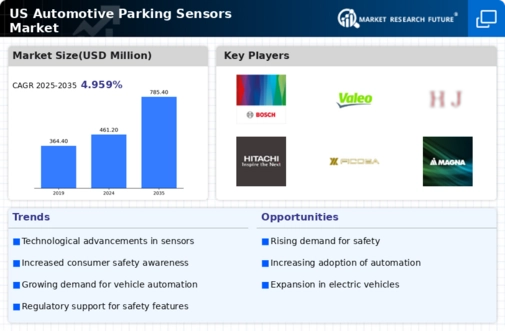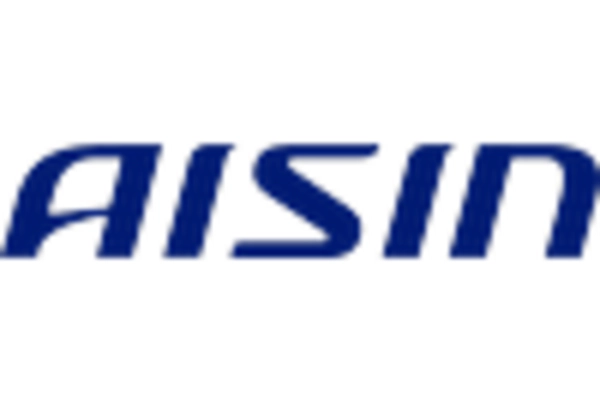Rising Urbanization
The increasing trend of urbanization in the United States is a pivotal driver for the automotive parking-sensors market. As more individuals migrate to urban areas, the demand for vehicles equipped with advanced parking technologies rises. Urban environments often present challenges such as limited parking space and high traffic density, which necessitate the use of parking sensors to enhance safety and convenience. According to recent data, urban areas are projected to account for over 80% of the US population by 2030, thereby amplifying the need for efficient parking solutions. This shift in demographics is likely to propel the automotive parking-sensors market, as consumers seek vehicles that offer enhanced parking assistance features to navigate congested urban landscapes.
Technological Integration in Vehicles
The integration of advanced technologies in vehicles is a significant driver for the automotive parking-sensors market. Innovations such as artificial intelligence, machine learning, and enhanced sensor technologies are being increasingly incorporated into vehicles, improving their parking capabilities. For instance, the adoption of 360-degree cameras and ultrasonic sensors has become more prevalent, allowing for better detection of obstacles and improved parking accuracy. The automotive parking-sensors market is expected to witness a growth rate of approximately 10% annually, driven by these technological advancements. As manufacturers continue to innovate and enhance vehicle safety features, the demand for sophisticated parking sensors is likely to increase, reflecting a broader trend towards smarter, more connected vehicles.
Government Initiatives for Road Safety
Government initiatives aimed at improving road safety are influencing the automotive parking-sensors market. Various state and federal programs are being implemented to promote the adoption of advanced safety technologies in vehicles. For example, the National Highway Traffic Safety Administration (NHTSA) has been advocating for the integration of parking assistance systems to reduce accidents related to parking maneuvers. These initiatives not only enhance public safety but also encourage manufacturers to invest in the development of innovative parking sensor technologies. As a result, the automotive parking-sensors market is likely to benefit from increased regulatory support and funding for research and development in this area.
Growth of Electric and Autonomous Vehicles
The rise of electric and autonomous vehicles is emerging as a significant driver for the automotive parking-sensors market. As the automotive industry shifts towards electrification and automation, the demand for advanced parking solutions is expected to grow. Electric vehicles (EVs) often come equipped with sophisticated parking technologies, and the development of autonomous vehicles necessitates the integration of advanced parking sensors for safe operation. The automotive parking-sensors market is anticipated to expand in tandem with the growth of these vehicle segments, as manufacturers seek to enhance the functionality and safety of their offerings. This trend indicates a potential for innovation and investment in parking sensor technologies, aligning with the broader movement towards sustainable and automated transportation.
Consumer Preference for Advanced Safety Features
Consumer preferences in the automotive sector are shifting towards vehicles equipped with advanced safety features, which is a crucial driver for the automotive parking-sensors market. Surveys indicate that over 70% of consumers prioritize safety technologies when purchasing a vehicle. This growing awareness of safety has led manufacturers to incorporate parking sensors as standard features in many new models. The automotive parking-sensors market is projected to expand as consumers increasingly demand vehicles that offer enhanced safety and convenience. This trend is further supported by the fact that insurance companies often provide discounts for vehicles equipped with advanced safety technologies, thereby incentivizing consumers to opt for models with parking sensors.

















Leave a Comment